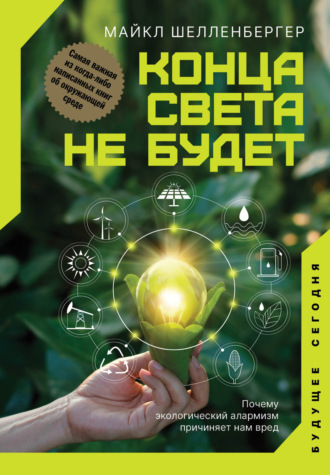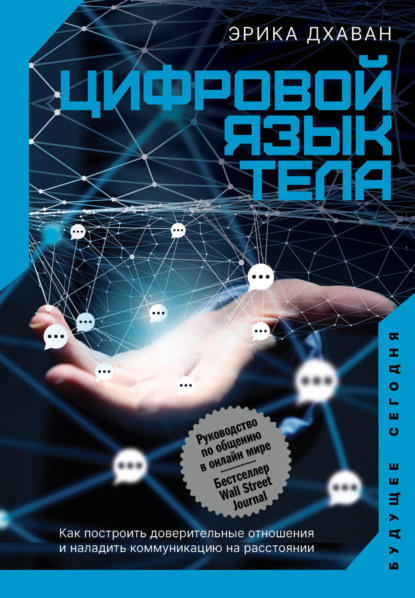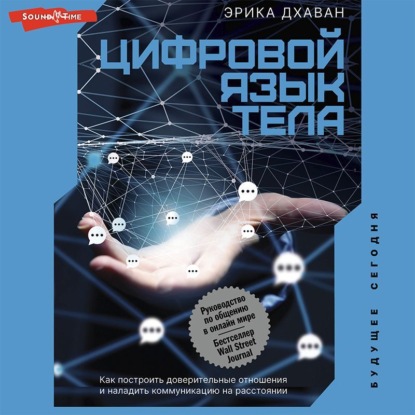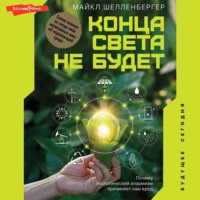
Полная версия
Конца света не будет. Почему экологический алармизм причиняет нам вред
114
Zion Lights, interviewed by Andrew Neil, The Andrew Neil Show, BBC, aired October 10, 2019, on BBC, https://www.youtube.com/watch?time_continue=7&v=pO1TTcETyuU&feature=emb_logo.
115
Здесь и далее: по состоянию на июль 2022 года Facebook, Instagram, Twitter и Linkedin внесены в реестр запрещенных сайтов на территории РФ.
116
Lauren Jeffrey, “An Open Letter to Extinction Rebellion,” YouTube (video), October 21, 2019, https://www.youtube.com/watch?v=iyYPLkWV3l0.
117
Peter James Spielmann, “UN Predicts Disaster if Global Warming Not Checked,” Associated Press, June 29, 1989, https://apnews.com.
118
Roger Pielke, Jr., “The Uninhabitable Earth – Future Imperfect,” Financial Times, March 8, 2019, https://www.ft.com.
119
Allyson Chiu, “ ‘It Snuck up on Us’: Scientists Stunned by ‘City-Killer’ Asteroid That Just Missed Earth,” «The Washington Post», July 26, 2019, www.washingtonpost.com.
120
Nick Perry, “Death toll from New Zealand volcano rises to 21 as victim dies from injuries nearly two months later,” Independent, January 29, 2020, https://www.independent.co.uk.
121
“ ‘Stealth Transmission’ Fuels Fast Spread of Coronavirus Outbreak,” Mailman School of Public Health at Columbia University, February 26, 2020, https://www.mailman.columbia.edu/public-health-now/news/stealth-transmission-fuels-fast-spread-coronavirus-outbreak.
122
Kerry Emanuel (climate scientist, MIT) in discussion with the author, November 15, 2019.
123
International Energy Agency, “Global CO2 Emissions in 2019,” February 11, 2020. European Commission, “Progress Made in Cutting Emissions,” accessed March 2, 2020. Carbon Brief, “Analysis: Why US carbon emissions have fallen 14 % since 2005,” August 15, 2017. BP Energy Data, 2019.
124
USA emissions from EIA, “US Carbon dioxide emissions from energy consumption (from 1973),” EIA, accessed February 1, 2020, https://www.eia.gov/environment/data.php. UK emissions from UK Department for Business, Energy and Industrial Strategy, “National Statistics: Provisional UK Greenhouse Gas Emissions National Statistics 2018,” UK government website, March 28, 2019, https://www.gov.uk/government/statistics/provisional-uk-greenhouse-gas-emis sions-national-statistics-2018.
125
Justin Ritchie (@jritch), “With this in mind, it is fair to say that the global energy system today, as modeled by IEA, is tracking much closer to 2˚ of warming this century than previously thought. Thread: 5/11,” Twitter, November 18, 2019, 9:37 a.m., https://twitter.com/jritch/status /1196482584710004736.
126
Leonardo DiCaprio (@leonardodicaprio), “#Regram #RG @rainforest alliance: The lungs of the Earth are in flames…,” Instagram photo, August 22, 2019, https://www.instagram.com/p/B1eBsWDlfF1/?utm_source=ig_web_button_share_sheet. Cristiano Ronaldo (@cristiano), “The Amazon Rainforest produces more than 20 % of the world’s oxygen and its been burning for the past 3 weeks. It’s our responsibility to help to save our planet. #prayforamazonia,” Twitter, August 22, 2019, https://twitter.com/Cristiano/status/1164588606436106240?s=20. Journalists, too, described the Amazon as the lungs of the world. “The Amazon remains a net source of oxygen today,” said a journalist on CNN. Susan Scutti, “Here’s What We Know About the Fires in the Amazon Rainforest,” CNN, August 24, 2019, https://www.cnn.com.
127
Alexandria Symonds, “Amazon Rainforest Fires: Here’s What’s Really Happening,” New York Times, August 23, 2019, https://www.nytimes.com.
128
Max Fisher, “ ‘It’s Really Close’: How the Amazon Rainforest Could SelfDestruct,” New York Times, August 30, 2019, https://www.nytimes.com.
129
Symonds, “Amazon Rainforest Fires: Here’s What’s Really Happening.”
130
Franklin Foer, “The Amazon Fires Are More Dangerous than WMDs,” The Atlantic, August 24, 2019. Alexander Zaitchik, “Rainforest on Fire,” The Intercept, July 6, 2019, https://theclimatecenter.org/rainforest-on-fire.
131
Emmanuel Macron, “Our house is burning. Literally. The Amazon rainforest – the lungs which produces 20 % of our planet’s oxygen – is on fire. It is an international crisis. Members of the G7 Summit, let’s discuss this emergency first order in two days! #ActForTheAmazon,” Twitter, August 22, 2019, 12:15 p.m., https://twitter.com/emmanuelmacron/status/1164617008962527232.
132
Kendra Pierre-Louis, “The Amazon, Siberia, Indonesia: A World of Fire,” New York Times, August 28, 2019, https://www.nytimes.com.
133
“Communication to the Committee on the Rights of the Child in the Case of Sacchi et al. v. Argentina et al.,” September 23, 2019, https://childrenvsclimatecrisis.org/wp-content/uploads/2019/09/2019.09.23-CRC-communication-Sacchi-et-al-v.-Argentina-et-al-2.pdf.
134
“Land Use,” Food and Agriculture Organization of the United Nations, http://www.fao.org/faostat/en/#data/RL.
135
Jane Brody, “Concern for the Rainforest Has Begun to Blossom,” New York Times, October 13, 1987, https://timesmachine.nytimes.com.
136
Michael Shellenberger, “An Interview with Founder of Earth Innovation, Dan Nepstad,” Environmental Progress, August 25, 2019, http://environmentalprogress.org/big-news/2019/8/29/an-interview-with-founder-of-earth-innovation-dan-nepstad.
137
Yadvinder Malhi, “Does the Amazon Provide 20 % of Our Oxygen?” August 24, 2019, http://www.yadvindermalhi.org/blog/does-the-amazon-provide-20-of-our-oxygen.
138
Doyle Rice, “What Would the Earth Be Like Without the Amazon Rainforest?” USA Today, August 28, 2019, https://www.usatoday.com.
139
Valerie Richardson, “Celebrities Get Fact-Checked After Sharing Fake Photos of Amazon Rainforest Fire,” Washington Times, August 26, 2019, https://www.washingtontimes.com.
140
“Aerial View of the Taim Ecological Station on Fire,” Baltimore Sun, March 29, 2013, http://darkroom.baltimoresun.com.
141
Niraj Chokshi, “As Amazon Fires Spread, So Do the Misleading Photos,” New York Times, August 23, 2019, https://www.nytimes.com.
142
“PRODES-Amazônia,” Instituto Nacional de Pesquisas Espaciais, November 18, 2019, accessed December 16, 2019, http://www.obt.inpe.br/OBT/assuntos/programas/amazonia/prodes.
143
“Monitoramento dos Focos Ativos por Países,” Queimadas Instituto Nacional De Pesquisas Espaciais, January 1, 2020, http://queimadas.dgi.inpe.br/queimadas/portal-static/estatisticas_paises.
144
Michael Shellenberger, “An Interview with Founder of Earth Innovation, Dan Nepstad,” Environmental Progress, August 25, 2019, http://environmentalprogress.org/big-news/2019/8/29/an-interview-with-founder-of-earth-innovation-dan-nepstad.
145
Luke Gibson, Tien Ming Lee, Lian Pin Koh et al., “Primary Forests Are Irreplaceable for Sustaining Tropical Biodiversity,” Nature, no. 478 (2011): 378–381, https://doi.org/10.1038/nature10425.
146
Years of Living Dangerously, season 2, episode 4, “Fueling the Fire,” directed by Jon Meyersohn and Jonathan Schienberg, National Geographic, November 16, 2016.
147
Michael Williams, Deforesting the Earth: From Prehistory to Global Crisis, an Abridgment (Chicago: University of Chicago, 2006), 87, 106.
148
Germany’s per capita carbon emissions in 2018 were 10.0 tons per capita as 82.8 million Germans emitted 830 million tonnes of CO2 equivalent. Brazil’s 211 million people emitted 2000 million tons of CO2 in 2018 including from Amazon deforestation and fires, a rate of 9.5 tonnes per capita. German emission data: German Federal Environmental Agency, “Indicator: Greenhouse gas emissions,” Umwelt Bundesamt, https://www.umweltbundesamt.de/en/indicator-greenhouse-gas-emissions. Brazil carbon emission data: “Total Emissions,” SEEG Brazil, accessed February 2, 2020, http://plataforma.seeg.eco.br/total_emission.
149
N. Andela, D. C. Morton, L. Giglio et al., “A human-driven decline in global burned area,” Science 356, no. 6345 (June 30, 2017): 1356–1362, https://doi.org/10.1126/science.aal4108. Xiao Peng Song, M. C. Hansen, S. V. Stehman et al., “Global land change from 1982 to 2016,” Nature, no. 560 (August 8, 2018): 639–643, https://doi.org/10.1038/s41586-018-0411-9.
150
Food and Agriculture Organization of the United Nations. FAO, “FAOSTAT Statistical Database,” FAOSTAT, accessed January 15, 2020, http://www.fao.org/faostat/en/#data. Between 1995 and 2015, forested area in Europe increased by over 17 million hectares. Belgium, the Netherlands, Switzerland, and Denmark are a combined 15.6 million hectares.
151
Alex Gray, “Sweden’s forests have doubled in size over the last 100 years,” World Economic Forum, December 13, 2018, https://www.weforum.org/agenda/2018/12/swedens-forests-have-been-growing-for-100-years.
152
Jing M. Chen, Weimin Ju, Philippe Ciais et al., “Vegetation Structural Change Since 1981 Significantly Enhanced the Terrestrial Carbon Sink,” Nature Communications 10, no. 4259 (October 2019): 1–7, https://www.nature.com/articles/s41467-019-12257-8.pdf.
153
“The significant reduction in deforestation that has taken place in recent years, despite rising food commodity prices, indicates that policies put in place to curb conversion of native vegetation to agriculture land might be effective. This can improve the prospects for protecting native vegetation by investing in agricultural intensification.” Alberto G. O. P. Barretto, Göran Berndes, Gerd Sparovek, and Stefan Wirsenius, “Agricultural Intensification in Brazil and Its Effects on Land-Use Patterns: An Analysis of the 1975–2006 Period,” Global Change Biology 19, no. 6 (2013): 1804–1815, https://doi.org/10.1111/gcb.12174.
154
Jing M. Chen et al., “Vegetation structural change since 1981 significantly enhanced the terrestrial carbon sink,” Nature Communications 10, no. 4259 (October 2019): 1–7, https://www.nature.com/articles/s41467-019-12257–8.pdf.
155
Jing M. Chen et al., “Vegetation structural change since 1981 significantly enhanced the terrestrial carbon sink,” Nature Communications 10, no. 4259 (October 2019): 1–7, https://www.nature.com/articles/s41467-019-12257–8.pdf.
156
Jon Lloyd and Graham D. Farquhar, “Effects of Rising Temperatures and Carbon Dioxide on the Physiology of Tropical Forest Trees,” Philosophical Transactions of the Royal Society 363, no. 1498 (February 2008): 1811–1817, https://doi.org/10.1098/rstb.2007.0032.
157
Sean M. McMahon, Geoffrey G. Parker, and Dawn R. Miller, “Evidence for a Recent Increase in Forest Growth,” Proceedings of the National Academy of Sciences of the United States of America 107, no. 8 (February 2010): 3611–3615, https://www.ncbi.nlm.nih.gov/pmc/articles/PMC2840472.
158
Alex Gray, “Sweden’s Forests Have Doubled in Size over the Last 100 Years,” World Economic Forum, December 13, 2018, https://www.weforum.org/agenda/2018/12/swedens-forests-have-been-growing-for-100-years.
159
A major study of 111 nations found a negative relationship between temperature and labor productivity that was statistically significant. In fact, researchers found that a nation’s temperature level is the second-most contributing factor to explaining labor productivity overall. The greatest contributing factor was simply already being a highly developed nation. Kemal Yildirim, Cuneyt Koyuncu, and Julide Koyuncu, “Does Temperature Affect Labor Productivity: Cross-Country Evidence,” Applied Econometrics and International Development 9, no. 1 (2009): 29–38, https://www.researchgate.net/profile/Cuneyt_Koyuncu/publication/227410116_Does_Temperature_Affect_Labor_Productivity_Cross-Country_Evidence/links/0a85e53467d19369e8000000/Does-Temperature-Affect-Labor-Productivity-Cross-Country-Evidence.pdf.
160
Pedro Renaux, “Poverty Grows and Poor Population in 2017 Amounts to 54.8 Million,” Agência IBGE, December 6, 2018, https://agenciadenoticias.ibge.gov.br/en/agencia-news/2184-news-agency/news/23316-poverty-grows-and-poor-population-in-2017-amounts-to-54-8-million.
161
“Amazon Tribes,” Survival International, accessed January 2, 2020, https://www.survivalinternational.org/about/amazontribes.
162
“Brazilian Indians,” Survival International, accessed January 2, 2020, https://www.survivalinternational.org/tribes/brazilian.
163
Linda Rabben, “Kayapo Choices: Short-Term Gain vs. Long-Term Damage,” Cultural Survival Quarterly Magazine, June 1995, https://www.culturalsurvival.org/publications/cultural-survival-quarterly/kayapo-choices-short-term-gain-vs-long-term-damage.
164
Michael Williams, Deforesting the Earth: From Prehistory to Global Crisis, an Abridgment, Ibid., 21–23.
165
Michael Williams, Deforesting the Earth: From Prehistory to Global Crisis, an Abridgment, Ibid., 19.
166
Christopher Sandom et al., “Global late Quaternary megafauna extinctions linked to humans, not climate change,” Proceedings of the Royal Society B, Biological Sciences 281, no. 1787 (2014), https://doi.org/10.1098/rspb.2013.3254/.
167
Michael Williams, Deforesting the Earth: From Prehistory to Global Crisis, an Abridgment, Ibid., 24–26.
168
Michael Williams, Deforesting the Earth: From Prehistory to Global Crisis, an Abridgment, Ibid., 25-29.
169
J. A. J. Gowlett, “Discovery of Fire by Humans: A Long and Convoluted Process,” Philosophical Transactions of the Royal Society B 371, no. 1696 (June 2016), http://dx.doi.org/10.1098/rstb.2015.0164.
170
J. A. J. Gowlett, “Discovery of Fire by Humans: A Long and Convoluted Process,” Philosophical Transactions of the Royal Society B 371, no. 1696 (June 2016), http://dx.doi.org/10.1098/rstb.2015.0164.
171
Michael Williams, Deforesting the Earth: From Prehistory to Global Crisis, an Abridgment, 146.
172
Keith Thomas, Man and the Natural World: Changing Attitudes in England, 1500–1800 (Oxford University Press, 1983), 192. Animals in England, writes a historian, “had been divided into the wild, to be tamed or eliminated, the domestic, to be exploited for useful purposes, and the pet, to be cherished for emotional satisfaction.”
173
Michael Shellenberger, “An Interview with Founder of Earth Innovation, Dan Nepstad,” Environmental Progress, August 25, 2019, http://environmentalprogress.org/big-news/2019/8/29/an-interview-with-founder-of-earth-innovation-dan-nepstad.
174
“Brazil and the Amazon Forest,” Greenpeace, accessed January 20, 2020, https://www.greenpeace.org/usa/issues/brazil-and-the-amazon-forest. Michael Shellenberger, “An Interview with Founder of Earth Innovation, Dan Nepstad,” Environmental Progress, August 25, 2019, http://environmentalprogress.org/big-news/2019/8/29/an-interview-with-founder-of-earth-innovation-dan-nepstad.
175
Michael Shellenberger, “An Interview with Founder of Earth Innovation, Dan Nepstad.”
176
Michael Shellenberger, “An Interview with Founder of Earth Innovation, Dan Nepstad.”
177
John Briscoe, “Infrastructure First? Water Policy, Wealth, and Well-Being,” Belfer Center, January 28, 2012, https://www.belfercenter.org/publication/infrastructure-first-water-policy-wealth-and-well-being.
178
John Briscoe, “Invited Opinion Interview: Two Decades at the Center for World Water Policy,” Water Policy 13, no. 2 (February 2011): 151, https://doi.org/10.2166/wp.2010.000.
179
John Briscoe, “Infrastructure First? Water Policy, Wealth, and Well-Being.”
180
Rhett Butler, “Greenpeace Accuses McDonald’s of Destroying the Amazon,” Mongabay, April 7, 2006, https://news.mongabay.com.
181
Michael Shellenberger, “An Interview with Founder of Earth Innovation, Dan Nepstad.”
182
Michael Shellenberger, “An Interview with Founder of Earth Innovation, Dan Nepstad.”
183
Michael Shellenberger, “An Interview with Founder of Earth Innovation, Dan Nepstad.”
184
Michael Shellenberger, “An Interview with Founder of Earth Innovation, Dan Nepstad.”
185
Michael Shellenberger, “An Interview with Founder of Earth Innovation, Dan Nepstad.”
186
Michael Shellenberger, “An Interview with Founder of Earth Innovation, Dan Nepstad.”
187
David P. Edwards et al., “Wildlife-Friendly Oil Palm Plantations Fail to Protect Biodiversity Effectively,” Conservation Letters 3 (2010): 236–42, https://doi.org/10.1111/j.1755-263X.2010.00107.x.
188
Michael Shellenberger, “An Interview with Founder of Earth Innovation, Dan Nepstad.”
189
Dave Keating, “Macron’s Mercosur Veto – Are Amazon Fires Being Used as a Smokescreen for Protectionism?” Forbes, August 23, 2019, https://www.forbes.com.
190
Dave Keating, “Macron’s Mercosur Veto – Are Amazon Fires Being Used as a Smokescreen for Protectionism?” Forbes, August 23, 2019, https://www.forbes.com.
191
Dave Keating, “Macron’s Mercosur Veto – Are Amazon Fires Being Used as a Smokescreen for Protectionism?” Forbes, August 23, 2019, https://www.forbes.com.
192
“Jair Bolsonaro to Merkel: Reforest Germany, Not Amazon,” Deutsche Welle, August 15, 2019, https://www.dw.com/en/jair-bolsonaro-to-merkel-reforest-germany-not-amazon/a-50032213.
193
“Brazil’s Lula Blasts Rich Nations on Climate,” Reuters, February 6, 2007, https://www.reuters.com.
194
“The analyses show that in agriculturally consolidated areas (mainly southern and southeastern Brazil), land-use intensification (both on cropland and pastures) coincided with either contraction of both cropland and pasture areas, or cropland expansion at the expense of pastures, both cases resulting in farmland stability or contraction. In contrast, in agricultural frontier areas (i.e., the deforestation zones in central and northern Brazil), land-use intensification coincided with expansion of agricultural lands. These observations provide support for the thesis that (i) technological improvements create incentives for expansion in agricultural frontier areas; and (ii) farmers are likely to reduce their managed acreage only if land becomes a scarce resource. The spatially explicit examination of land-use transitions since 1960 reveals an expansion and gradual movement of the agricultural frontier toward the interior (center-western Cerrado) of Brazil.” Barretto et al., “Agricultural Intensification in Brazil and Its Effects on Land-Use Patterns: An Analysis of the 1975–2006 Period.”
195
Bernardo B. N. Strassburg, Agnieszka E. Lataweic, Luis G. Barioni et al., “When Enough Should Be Enough: Improving the Use of Current Agricultural Lands Could Meet Production Demands and Spare Natural Habitats in Brazil,” Global Environmental Change 28 (September 2014): 84–97, https://doi.org/10.1016/j.gloenvcha.2014.06.001.
196
Philip K. Thornton and Mario Herrero, “Potential for Reduced Methane and Carbon Dioxide Emissions from Livestock and Pasture Management in the Tropics,” Proceedings of the National Academy of Sciences of the United States of America 107, no. 46 (November 2010): 19667–72, https://doi.org/10.1073/pnas.0912890107.
197
Michael Shellenberger, “An Interview with Founder of Earth Innovation, Dan Nepstad.”
198
Juliana Gil, Rachael Garrett, and Thomas Berger, “Determinants of Crop-Livestock Integration in Brazil: Evidence from the Household and Regional Levels,” Land Use Policy 59, no. 31 (December 2016): 557–568, https://doi.org/10.1016/j.landusepol.2016.09.022.
199
LaMont C. Cole, “Man’s Ecosystem,” BioScience 16, no. 4 (April 1966): 243–48, https://doi.org/10.2307/1293563/. Wallace S. Broecker, “Man’s Oxygen Reserves,” Science 168, no. 3939 (June 1970), 1537–38, https://doi.org/10.1126/science.168.3939.1537. Broecker ended his article “Hopefully the popular press will bury the bogeyman it created.” I am grateful to Mark Sagoff for bringing this history to my attention.
200
Christine Figgener, “Sea Turtle with Straw up Its Nostril–‘NO’ TO PLASTIC STRAWS,” YouTube, August 10, 2015, https://www.youtube.com/watch?v=4wH878t78bw.
201
Christine Figgener, “Sea Turtle with Straw up Its Nostril–‘NO’ TO PLASTIC STRAWS,” YouTube, August 10, 2015, https://www.youtube.com/watch?v=4wH878t78bw.
202
Michael A. Lindenberger, “How a Texas A&M Scientist’s Video of a Sea Turtle Soured Americans on Drinking Straws,” Dallas Morning News, July 19, 2018, https://www.dallasnews.com.
203
Hilary Brueck, “The Real Reason Why So Many Cities and Businesses Are Banning Plastic Straws Has Nothing to Do with Straws at All,” Business Insider, October 22, 2018, https://www.businessinsider.com.
204
Sophia Rosenbaum, “She Recorded That Heartbreaking Turtle Video. Here’s What She Wants Companies like Starbucks to Know About Plastic Straws,” Time, July 17, 2018, https://time.com.
205
Jenna R. Jambeck, Roland Geyer, Chris Wilcox et al., “Plastic Waste Inputs from Land into the Ocean,” Science 347, no. 6223 (February 2015): 768–771, http://doi.org/10.1126/science.1260352.
206
Christine Figgener (sea turtle biologist) in conversation with the author, November 6, 2019.
207
Chris Wilcox, Melody Puckridge, Gamar A. Schuyler et al., “A Quantitative Analysis Linking Sea Turtle Mortality and Plastic Debris Ingestion,” Scientific Reports 8 (September 2018): article no. 12536, https://www.nature.com/articles/s41598-018-30038-z.pdf. Chris Wilcox, Nicholas J. Mallos, George H. Leonard et al., “Using Expert Elicitation to Estimate the Impacts of Plastic Pollution on Marine Wildlife,” Marine Policy 65 (March 2016): 107–14, https://doi.org/10.1016/j.marpol.2015.10.014.
208
Christine Figgener (sea turtle biologist) in conversation with the author, November 6, 2019/.
209
Leandro Bugoni, L’igia Krause, and Maria Virgínia Petry, “Marine Debris and Human Impacts on Sea Turtles in Southern Brazil,” Marine Pollution Bulletin 42, no. 12 (December 2001): 1330–1334, https://doi.org/10.1016/S0025-326X(01)00147-3.







